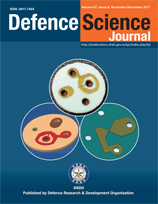Standoff Detection of Explosives at 1 m using Laser Induced Breakdown Spectroscopy
DOI:
https://doi.org/10.14429/dsj.67.11498Keywords:
Laser induced breakdown spectroscopy, Explosive detection, Principal component analysis, Multivariate analysisAbstract
We report the ‘standoff detection’ of explosives at 1 m in laboratory conditions, for the first time in India, using Laser Induced Breakdown Spectroscopy combined with multivariate analysis. The spectra of a set of five secondary explosives were recorded at a distance of 1 m from the focusing as well as collection optics. The plasma characteristics viz., plasma temperature and electron density were estimated from Boltzmann statistics and Stark broadening respectively. Plasma temperature was estimated to be of the order of (10.9 ± 2.1) .103 K and electron density of (3.9 ± 0.5) .1016 cm-3. Using a ratiometric approach, C/H and H/O ratios showed a good correlation with the actual stoichiometric ratios and a partial identification success could be achieved. Finally employing principle component analysis, an excellent classification could be attained.
Downloads
Published
How to Cite
Issue
Section
License
 Where otherwise noted, the Articles on this site are licensed under Creative Commons License: CC Attribution-Noncommercial-No Derivative Works 2.5 India
Where otherwise noted, the Articles on this site are licensed under Creative Commons License: CC Attribution-Noncommercial-No Derivative Works 2.5 India


